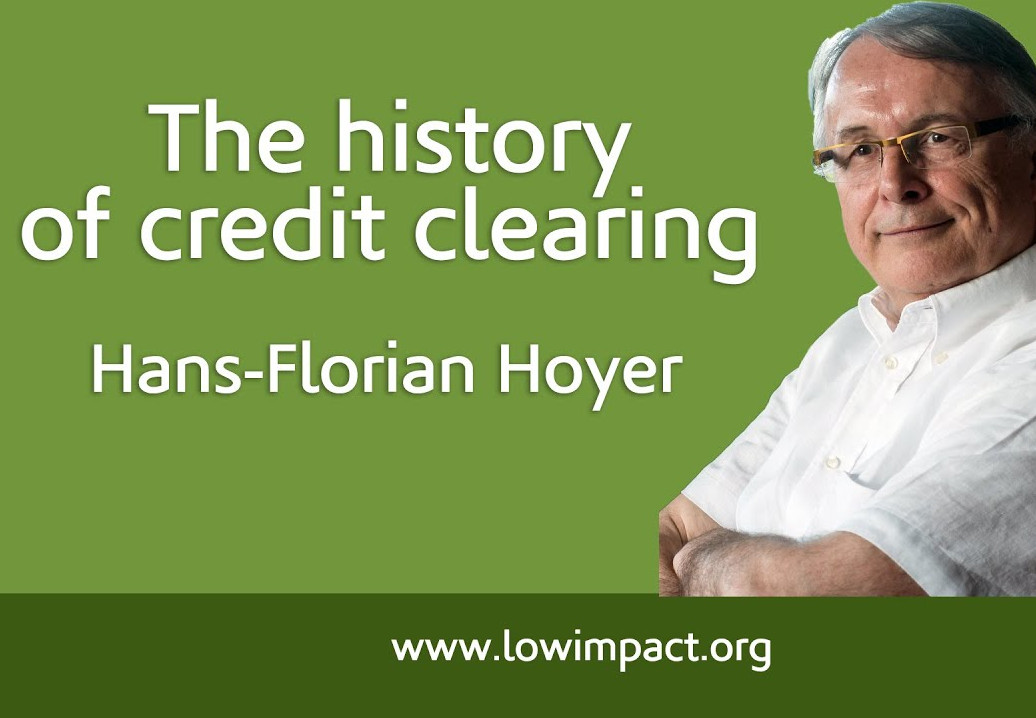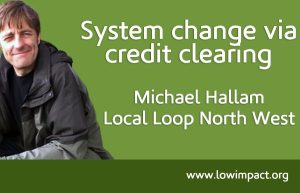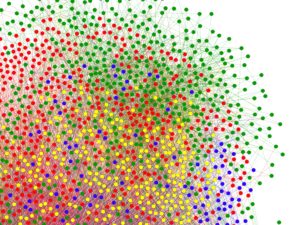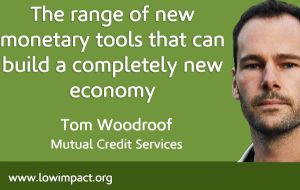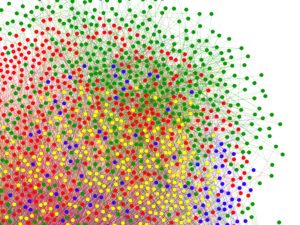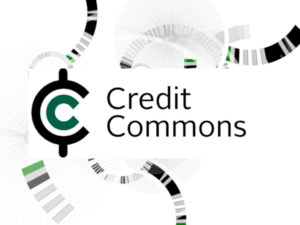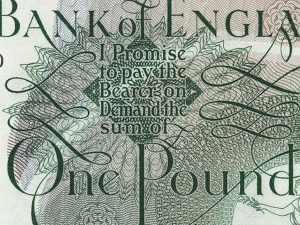Here I’m talking with Hans-Florian Hoyer – a retired banker and academic who specialises in the history of credit clearing – especially credit clearing at medieval trade fairs. Credit clearing is a crucial part of building a new commons economy, because it reduces the need for money and banks in communities, and it helps small businesses survive through difficult times – which there seem to be a lot of nowadays.
Here’s a summary of our conversation:
Hans-Florian spent 25 years in the banking industry, working at the first social-ecological bank in Europe, and possibly the world. It was founded in 1974 by anthroposophists. It was a bank for communities (Gemeinschaftsbank) – a bank that could be used by the community for building a new barn or a bakery etc. They invented crowdfunding. The community banded together, each person guaranteeing a certain amount of money. With these guarantees, the bank had the security to make the loan.
Previously, he studied engineering and architecture. There was a professor there – Horst Rittel, who along with colleagues at Berkeley, pioneered the concept of ‘wicked problems’ (in which there are no rules to follow, and the solution may not be repeatable). He became assistant professor at Rittel’s chair. It was only later, during his time at the bank, that he became interested in credit clearing.
Money creation
When he started working in banking, he didn’t understand money creation. He believed that banks lent out the deposits of savers, which later he understood not to be true. After the financial crash of 2008, he ‘woke up’ and started to ask questions about money creation, and then after he retired, he started to read more about money. He wanted to discover something like the periodic table of elements for money – to organise all the diverse parts into a comprehensible system.
In other words, he didn’t begin to really understand money until he stopped being a banker – which he says is typical.
When he investigated the history of money, he felt as if he were entering a zoo, with different cages containing different money ‘animals’. He thought a lot about what kind of money would be appropriate for the future. As an anthroposophist, he looked at what Rudolf Steiner wrote about money. He obtained a very different perspective from Steiner.
Money confers the right to claim something, but most people think of money in terms of tokens / coins – and as long as this is the case, they will be in the hands of those who understand how money really works, and can be easily exploited. Thinking in terms of tokens is no longer appropriate in a credit economy. But the finance sector uses vocabulary that makes it difficult for non-speciailists to understand the nature of money. In 2007-8, the kinds of instruments created by specialists, to make even more money, were incomprehensible even to most bankers. Hans-Florian would like to help people understand the money system.
Value
Money wasn’t one single invention, but a co-creation of everyone doing business together in society. The main thing he wishes people understood about money is that it doesn’t contain any intrinsic value. The concept of value is important, and it’s comparable to the concept of distance. Nobody would ask: what intrinsic distance does London have? It depends on other places. It’s the same with value. Value is always about a comparison between things. For example, the value of a pearl has been explained by the difficulty in obtaining it, but if a diver brought up a stone instead of a pearl, it would have the same difficulty but not the same value.
Since Nixon took the dollar off gold in 1971, there’s no material value backing anything. This raises the question: what do we owe each other when we hand over money? This is a huge question for society. He did some research into where people were asking this question, and discovered the work of Tomaz Fleischman, Dil Green, Matthew Slater et al – with Mutual Credit Services and the Credit Commons Society. He started working with them, providing them with some historical information.
Credit clearing at medieval trade fairs
In the middle ages, there were important trade fairs in France, where textiles producers from Britain and northern Europe met merchants coming from upper Italy and southern Europe. Everyone had to take an overland journey to the fairs, often through woodlands containing bandits – so it wasn’t a good idea to carry gold coins.
First they invented the bill of exchange, representing deposits in banks / strongrooms in their home country, with partners around the continent from where they could make a withdrawal. The merchants only carried enough money to pay for food and accommodation.
This was also a way to get around the religious ban on charging interest. As the different currencies were exchanged, interest charges were hidden in the maths.
At the fairs, trading was recorded in books, and at the end of the fair, there were consolidation meetings, where trading partners met and cleared debts with each other bilaterally (so for example, if two trading partners discovered that they each owed the other 50 francs, it could just be cleared rather than each finding the money to pay). If there were debts that couldn’t be cleared, traders would ask who owed their partners money, so that they could see if any debt could be cleared with them instead. They also tried to find little trading circles where debts could be cleared between more than two trading partners (if A owes B, owes C, owes D, owes A – they could eliminate the smallest debt between them by clearing).
Compensation between two parties was called ‘scontration’ if it was between three or more parties. Then, when there were no more debts that could be cleared, they wrote down a letter of exchange so that they could be carried over to the next trade fair.
The way that the merchants discovered these trading loops was by standing shoulder-to-shoulder to each other. The right shoulder represented ‘I owe this person’ and the left shoulder represented ‘this person owes me’. If physical circles were formed, then debt could be cleared by subtracting the smallest figure from all debts. This sounds like magic – but think about it. It works.
This scontration process could continue for a few days or a week after the fair had ended. In Lyon, specialist money-changers were employed to clear the debts, and the books were handed over to these specialists at the end of the fair.
Although clearing between two parties has happened forever, this was the earliest example of credit clearing between three or more parties.
The move to maritime trade
This scontration ceased in the later middle ages, when fairs became ‘sample fairs’ where trades didn’t happen – instead, samples were shown and deliveries between countries were organised. At the same time, trade became more maritime, and port cities – especially Amsterdam – became centres of trade, rather than inland trade fairs, which merchants travelled to overland.
A shortage of coins became a problem in these coastal trading cities, so that deposits of gold and silver were made into the vaults of the banks of those cities, and then trades happened via the banks’ books, rather than with physical coins. But traders had to have the precious metal in the bank vaults to back their ‘on paper’ trades 100%.
Adam Smith wondered whether the gold and silver existed in the banks in Amsterdam to cover all transactions. At that time, it actually did – it was only later that banks began to lend money (for example, to the Dutch East India Company) and diluted the backing of the numbers in their books.
After Amsterdam, London became the centre of world trade and the Bank of England became the first central bank with control over the issuance of a country’s bank notes.
Banks start clearing between themselves
Every sovereign was afraid of what John Law did to France, with his paper-money issuing and speculative schemes that eventually collapsed and ruined the country. To prevent this, the govt. in London prevented anyone except the Bank of England from printing money. The response from private banks, who weren’t allowed to issue banknotes, was to give customers cheque books. People were to deposit coins, receive a cheque book for payments, and recipients of the cheques could claim the coins, via their own bank. ‘Walking clerks’ walked between banks in the city, carrying money from bank to bank for the recipients of cheques. It wasn’t much work at first, but as more people received cheque books, more money had to be carried from bank to bank.
The story is that groups of walking clerks met in coffee shops in London and came up with the idea of clearing between banks, to save their time and shoe leather. Apparently, the CEOs of banks liked their idea and built a clearing house in the city. This was a private club of bank CEOs, with no legal restrictions on their activities. They sent their clerks each day to the clearing house; each bank had a table, and clerks put cheques payable by each bank on their table. Later in the day, moneys could be transferred to cover the cheques. Since each bank was receiving money from and paying money to other banks, it was easy to see that a clearing system would be more efficient.
By the middle of the 19th century, clearing was done via the banks’ accounts at the Bank of England. The Bank of England opened an account for the clearing house. Banks who had to pay or receive moneys did so via the clearing house account at the Bank of England. Because of clearing, banks required less than 10% of the cash deposited to pay their debts (see image).

The rest of Europe could see that London didn’t have much gold (compared to France, for example), but a huge amount of global trade, and they wondered how it was done. It was done via credit clearing and it was why the City of London got such a head start in the world of global finance, and why the British Empire grew faster than other European empires.
It’s amazing to think that the work of the clearing house was done entirely with paper and pencils. There was an overall supervisor, with a team of bank clerks doing the sums – who were no longer walking, but scribbling. [The banks do all this electronically (continuously) now of course].

The start of ‘fractional reserve’ banking
When the banks realised that they needed less than 10% of the money deposited by customers to conduct their business, they started to issue cheque books that didn’t require deposits backing them – and this was the real start of ‘fractional reserve banking’ and the move from a money economy to a credit economy. This allowed the financing of huge infrastructure projects such as the railways in the booming industrial revolution. There’s no way that the railways could have been funded with coins.
How the history of credit clearing relates to what’s happening today
The main thing to understand is that money is not a ‘thing’ in itself, but a claim on somebody. The radical upshot of this is that we can create money ourselves. We can agree that I can claim something of value from you because I provided something of value for you, or for someone else in a network of which you are part. We are perfectly free to do this. And we don’t have to insist on immediate payment. We can look at the trading / exchange loops in the network, and clear a lot of the obligations so that much less cash is required to settle.
There are some modern credit clearing systems between small businesses being set up now, and the WIR Bank in Switzerland has been operating a clearing system for businesses since the 1930s depression (when there was a shortage of money).
Credit clearing can happen between businesses anywhere in the world. All that’s required is the will, the understanding, and a spreadsheet. With participating businesses listed along the top and down the left column, rows indicate what each business is owed by another, and columns indicate what they owe. The difference can be cleared.
If clearing is good enough for the banks, it’s good enough for us. It’s time for civil society to take advantage of this tool. There’s no licensing or regulations to comply with because no money is involved – only information.
Highlights
- At medieval trade fairs, merchants discovered trading loops by standing shoulder-to-shoulder to each other. The right shoulder represented ‘I owe this person’ and the left shoulder represented ‘this person owes me’. If physical circles were formed, then debt could be cleared by subtracting the smallest figure from all debts.
- The story is that groups of walking clerks met in coffee shops in London and came up with the idea of clearing between banks, to save their time and shoe leather. Apparently, the CEOs of banks liked their idea and built a clearing house in the city.
- If clearing is good enough for the banks, it’s good enough for us. It’s time for civil society to take advantage of this tool. There’s no licensing or regulations to comply with because no money is involved – only information.

